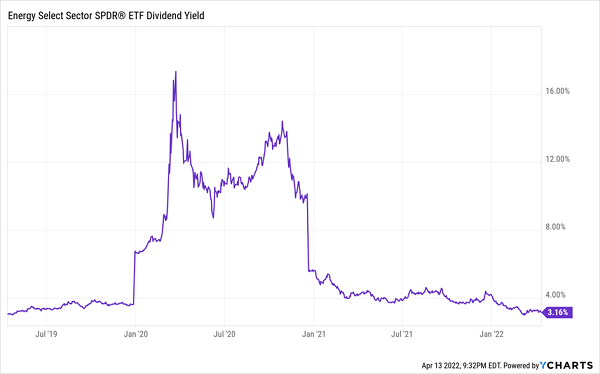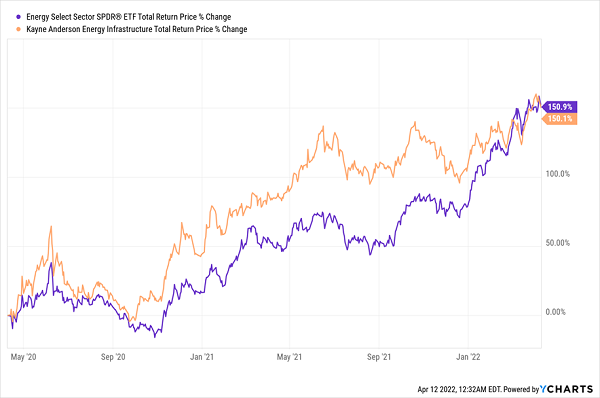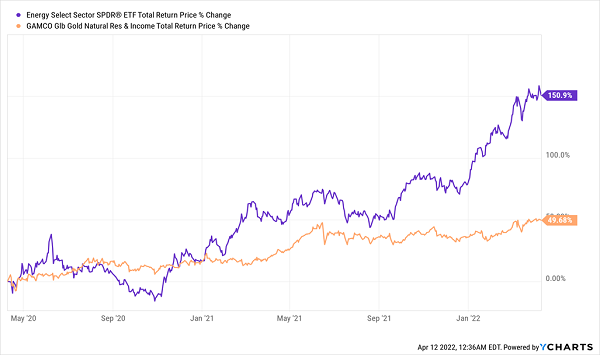If you’ve sat out oil stocks until now, it’s easy to think you missed the boat. After all, oil’s big run has sent shares of producers (and pipeline operators) soaring. That’s meant lower dividend yields—and higher valuations—for folks who decide to tiptoe in now.
But there’s a way we can “turn back the clock” and squeeze 8.1%, 8.7%, and even 8.9% dividends out of energy stocks. (These are the actual yields on three overlooked funds I’ll show you in a moment.)
Those are the kinds of yields you could only get back in April 2020, in the teeth of the COVID crisis, when oil stocks were on their backs, their depressed prices sending their yields soaring. These days, folks who buy these stocks independently or through an exchange-traded fund (ETF) have to settle for a lot less income.
Consider the benchmark ETF for the space, the Energy Select Sector SPDR® Fund (NYSE:XLE), which holds shares of major producers like ExxonMobil (NYSE:XOM), Chevron (NYSE:CVX), and ConocoPhillips (NYSE:COP).
Back in March 2020, its yield spiked north of 15%! But (no) thanks to the energy rally, it pays just over 3% today:
XLE Only Offers A Decent Yield In Heart-Stopping Plunges

I’m not telling you this to put you off buying energy stocks now. Far from it! I’m writing to tell you that we can still get big yields from energy without having to buy in a selloff, and at a discount to today’s prices. The key? My favorite investments: high-yield closed-end funds (CEFs).
Let’s talk tickers, with those three energy-focused CEFs (yielding 8%+) I mentioned a second ago:
Energy CEF No. 1: An 8.1% Payer That Crushes Its Benchmark
Let’s start with the lowest yielding of our trio, the “mere” 8.1%-paying Tortoise Energy Infrastructure Closed Fund (NYSE:TYG), which still pays well over double what XLE gets you.
As the name suggests, TYG invests in the companies involved in the basic infrastructure of producing and distributing energy, which is why Williams Companies (NYSE:WMB), NextEra Energy Partners (NYSE:NEP), and ONEOK (NYSE:OKE) are top holdings.
These stocks have helped TYG far outperform even the record-beating two years the broader energy sector has put in.
TYG Outruns A Hot Oil Market

TYG also trades at the largest discount of our trio, with a market price 17.6% below the actual liquidation of its portfolio. This discount to net asset value (NAV, or the value of the stocks in TYG’s portfolio) means we’re essentially paying 82 cents for every dollar of TYG’s assets.
Energy CEF No. 2: An 8.7% Payer With Upside Ahead
Next up, the Kayne Anderson MLP Investment Closed Fund (NYSE:KYN) similarly trades at a 15.3% discount to NAV while offering a slightly higher yield of 8.7%.
That’s because of its focus on master limited partnerships (MLPs), which exist to pass through income from energy projects directly to investors in the form of dividends.
Leading MLPs like MPLX (NYSE:MPLX), Enterprise Products Partners (NYSE:EPD), and Energy Transfer LP (NYSE:ET) are its biggest holdings.
Matching The Market

KYN’s recent return, matching the energy market, isn’t as impressive as that of TYG, but that also means there’s more room for KYN’s assets to climb if oil prices continue to rise (or even hold steady).
The fund also has less exposure to producers, and with MLPs more geared to income-seekers, it hasn’t been bid to the levels TYG has.
That explains KYN’s higher dividend and opens the door to further upside as investors look to hedge on the always-unpredictable energy sector by getting more of their return in cash.
Another thing you may have heard about MLPs is that they send you a complicated K-1 package for reporting the income you get from these investments. But you don’t have to worry about that when you buy your MLPs through KYN. The fund sends you a simple Form 1099 at tax time.
Energy CEF No. 3: The Ultimate Inflation Hedge
Finally, there’s the GAMCO Global Gold, Natural Resources & Income Fund (NYSE:GGN), which is priced at a narrower 6% discount to NAV.
Part of that might be because of its high yield, at 8.9%. Another part is likely because GGN is one of the few funds that lets you buy both gold stocks and energy stocks—both proven inflation hedges—in a single buy.
And GGN holds leading companies in both areas, including Exxon, Chevron, and Shell (NYSE:SHEL) on the energy side and leading gold miners such as Newmont Goldcorp (NYSE:NEM), Barrick Gold (NYSE:GOLD), and Franco-Nevada (NYSE:FNV).
There’s another reason to consider GGN: its recent performance gives it room to run.
A Modest Two Years

The relatively low returns for GGN over the last two years make sense; in 2020 and the first half of 2021, inflation wasn’t a top-of-mind concern, but rising inflation worries helped bump up the fund’s returns in the middle of last year.
But the fund has since leveled off, even though inflation expectations remain heightened, setting it up for another upside bounce. While you wait for that to happen, you’ll be pocketing the fund’s rich 8.9% yield.
Disclosure: Brett Owens and Michael Foster are contrarian income investors who look for undervalued stocks/funds across the U.S. markets. Click here to learn how to profit from their strategies in the latest report, "7 Great Dividend Growth Stocks for a Secure Retirement."
